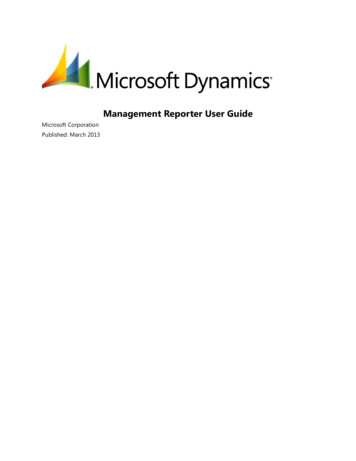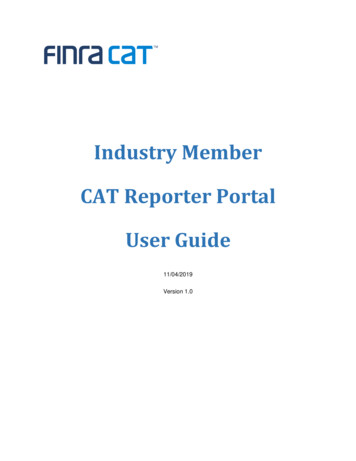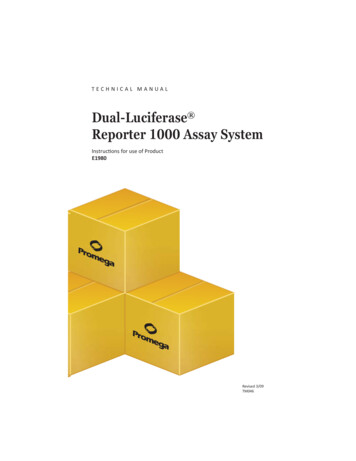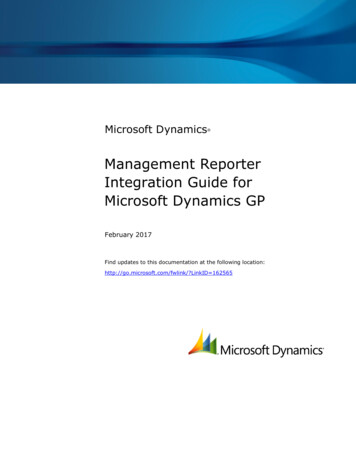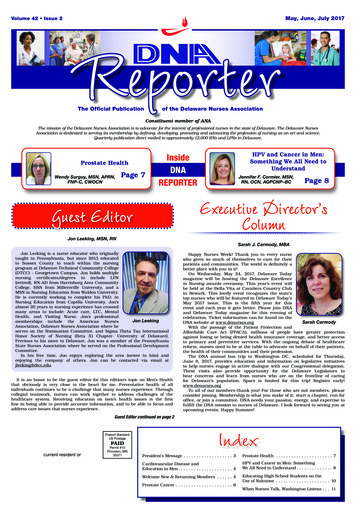
Transcription
May, June, July 2017Volume 42 Issue 2ReporterThe Official Publicationof the Delaware Nurses AssociationConstituent member of ANAThe mission of the Delaware Nurses Association is to advocate for the interest of professional nurses in the state of Delaware. The Delaware NursesAssociation is dedicated to serving its membership by defining, developing, promoting and advancing the profession of nursing as an art and science.Quarterly publication direct mailed to approximately 12,000 RNs and LPNs in Delaware.Prostate HealthWendy Surguy, MSN, APRN,FNP-C, CWOCNPage 7HPV and Cancer in Men:Something We All Need toUnderstandInsideDNAREPORTERJennifer F. Cormier, MSN,RN, OCN, AGPCNP–BCPage 8Executive Director’sColumnGuest EditorJon Leeking, MSN, RNSarah J. Carmody, MBAJon Leeking is a nurse educator who originallytaught in Pennsylvania, but since 2013 relocatedto Sussex County to teach within the nursingprogram at Delaware Technical Community College(DTCC) - Georgetown Campus. Jon holds multiplenursing certificates/degrees to include LPN(retired), RN-AD from Harrisburg Area CommunityCollege, BSN from Millersville University, and aMSN in Nursing Education from Walden University.He is currently working to complete his PhD. inNursing Education from Capella University. Jon’salmost 20 years in nursing experience has crossedmany areas to include: Acute care, LTC, MentalHealth, and Visiting Nurse. Jon’s professionalJon Leekingmemberships include the American NursesAssociation, Delaware Nurses Association where heserves on the Nomination Committee, and Sigma Theta Tau InternationalHonor Society of Nursing (Beta Xi Chapter- University of Delaware).Previous to his move to Delaware, Jon was a member of the PennsylvaniaState Nurses Association where he served on the Professional DevelopmentCommittee.In his free time, Jon enjoys exploring the area (newer to him) andenjoying the company of others. Jon can be contacted via email atjleeking@dtcc.edu.It is an honor to be the guest editor for this edition’s topic on Men’s Healththat obviously is very close to the heart for me. Preventative health of allindividuals continues to be a challenge that many nurses experience. Throughcollegial teamwork, nurses can work together to address challenges of thehealthcare system. Receiving education on men’s health issues is the firstline in being able to provide accurate information, and to be able to focus andaddress care issues that nurses experience.Happy Nurses Week! Thank you to every nursewho gives so much of themselves to care for theirpatients and communities. The world is definitely abetter place with you in it!On Wednesday, May 24, 2017, Delaware Todaymagazine will be hosting the Delaware Excellencein Nursing awards ceremony. This year’s event willbe held at the Bella Vita at Cavaliers Country Clubin Newark. This lovely event recognizes the state’stop nurses who will be featured in Delaware Today’sMay 2017 issue. This is the fifth year for thisevent and each year it gets better. Please join DNAand Delaware Today magazine for this evening ofcelebration. Ticket information can be found on theSarah CarmodyDNA website at www.denurses.orgWith the passage of the Patient Protection andAffordable Care Act (PPACA), millions of people have greater protectionagainst losing or being denied health insurance coverage, and better accessto primary and preventive services. With the ongoing debate of healthcarereform, nurses need to be at the table to advocate on behalf of their patients,the health of their communities and their profession.The DNA annual bus trip to Washington DC, scheduled for Thursday,June 8, 2017, provides education and information on legislative initiativesto help nurses engage in active dialogue with our Congressional delegation.These visits also provide opportunity for the Delaware Legislators tohear concerns and learn from nurses who are on the frontline of caringfor Delaware’s population. Space is limited for this trip! Register early!www.denurses.orgTo all of our members-thank you! For those who are not members, pleaseconsider joining. Membership is what you make of it; start a chapter, run foroffice, or join a committee. DNA needs your passion, energy, and expertise tofulfill the DNA mission to nurses of Delaware. I look forward to seeing you atupcoming events. Happy Summer!Guest Editor continued on page 2Presort StandardUS PostagePAIDcurrent resident orPermit #14Princeton, MN55371President’s Message . . . . . . . . . . . . . . . . . . . . 3Prostate Health . . . . . . . . . . . . . . . . . . . . . . . 7Cardiovascular Disease andEducation in Men. . . . . . . . . . . . . . . . . . . . . . 4HPV and Cancer in Men: SomethingWe All Need to Understand. . . . . . . . . . . . . . . 8Welcome New & Returning Members . . . . . . . 4Educating High School Students on theUse of Naloxone . . . . . . . . . . . . . . . . . . . . . . 10Prostate Cancer . . . . . . . . . . . . . . . . . . . . . . . 6When Nurses Talk, Washington Listens. . . . 11
Page 2 DNA ReporterGuest Editor continued from page 1As a nurse educator, and as a practicing clinician,I see and experience the lack of knowledge in men’shealthcare not only from the student level, but alsofrom the practicing nurse, and most definitely fromthe healthcare consumers. Without pulling anyamount of politics into this conversation, nursesshould know that “prevention is worth a pound ofcure.” As such, nurses can play a crucial part in theeducation of clients and colleagues.Probably the single most significant risk factorfor long-term morbidity and premature mortality isnot smoking, but simply being male. One in five menwill die before he reaches his 65th birthday. So whatcan general practice nurses do to tackle this ‘genderdeficit?’Advances in healthcare and treatment optionsmean that life expectancy is increasing – but not foreveryone: throughout the developed world, womengenerally speaking-live longer than men. The mostrecent data show that this gender gap is 5.3 years.There has been considerable research into the reasonsfor this discrepancy, not least into an apparentreluctance by men to seek medical help or adviceand why this is the case. Practice nurses are at theforefront of health promotion but face a formidabletask in tackling the issues, given that the consultationrate for men is 32% lower than it is for women.What barriers must nurses overcome?Some 90% of interactions between patientshappen in general practice but despite the wideMay, June, July 2017range of services offered in the average practice,many of which are provided by advanced practiceregistered nurses, men have far fewer contactswith their GP than women do. A survey on behalfof the Blue Ribbon Foundation (n.d.) – a charitywhich supports men’s health initiatives found thatnot only had one in five men not visited a doctor orother healthcare professional in the last 12 months,but 6% would not do so even if they experiencedchest pain. Only 14% of men questioned said theywere happy to go ‘to the doctor’s’ if necessary, butmore tellingly, a third would only see their GP iftheir partner made them go, or ‘if they really had to’(Perry, 2015).I am excited to share the articles written for thisedition of the DNA Reporter as explored will be upto-date information related to men’s health careissues. The first article by Mark Coldwell, BNS, RN,CCRN and Ryan Miller, BNS, RN, CCRN is focusedon cardiovascular disease in men. The authorsemphasize the importance of educating men aboutthis health issue as research indicates that menas a whole, do not seek out health care for earlyintervention. The second article by Leslie Verucci,MSN, RN, APRN-APN and Jennifer Cormier MSN,RN, OCN, AGPCNP–BC will be a discussion onprostate cancer and current information relatedto risk factors, diagnostic criteria, prescribedtreatment, and prognosis for the disease state.The third article by Wendy Surguy, MSN, APRN,FNP-C, CWOCN additionally explores morbidityand mortality associated with prostate cancer andfurther emphasizes diagnostic criteria. The finalarticle on men’s health care concerns is written byJennifer Cormier, MSN, RN, OCN who will shareinformation on the human papillomavirus (HPV)and its increasing frequency in head and neckcancers.Reference:Perry, Margaret (2015). “Improving men’s health.” PracticeNurse: The Journal for Nurses in General Practice, 45(11),p. 16.ReporterOFFICIAL PUBLICATIONof theDelaware Nurses Association4765 Ogletown-Stanton Road, Suite L10Newark, DE 19713Phone: 302-733-5880Web: http://www.denurses.orgThe DNA Reporter, (ISSN-0418-5412) is published quarterlyevery February, May, August and November by theArthur L. Davis Publishing Agency, Inc., for the DelawareNurses Association, a constituent member association ofthe American Nurses Association.executive committeePresidentLeslie Verucci, RN, MSN,CNS, CRNP-A, APRN-BCTreasurerFelisha A. Alderson,MSN, RN, CRRNSecretaryChristopher E. Otto, BSN, RN, CHFN, PCCNcommittee CHAIRSContinuing EducationWayne Voelmeck, MSN, PhDCommitteeon NominationJon M. Leeking, MSN, RNProfessional DevelopmentMay Oboryshko, DNP, RNLegislativeMembers of the Board of DirectorsCommunicationsWilliam T. Campbell, Ed.D, RNKaren Panunto, Ed.D, MSN, RN, APRNExecutive DirectorSarah J. Carmody, MBASubscription to the DNA Reporter may be purchased for 20per year, 30 per year for foreign addresses.Vision: Delaware Nurses Association isthe leading voice, authority, and advocatefor the nursing professional in the state ofDelaware.Division of Prevention &Behavioral Health ServicesReach us at: 1-800-722-7710www.kids.delaware.govMission: Delaware Nurses Associationprovides leadership for the nursing professionand promotes quality health care forconsumers through education, advocacy, andinfluencing health care policy in the state ofDelaware.Goals: Delaware Nurses Association will: Promote and lead the nursing professionon issues and trends that affectprofessional practice Promote and support excellence fornurses in practice, education, andresearch Promote professional development andrespond to the changing needs of nursesin Delaware Maintain and strengthen nursing’s role inclient advocacy for consumer safety andquality healthcareUpdated July 2016http://www.denurses.orgPublished by:Arthur L. DavisPublishing Agency, Inc.For advertising rates and information, please contact Arthur L.Davis Publishing Agency, Inc., 517 Washington Street, PO Box216, Cedar Falls, Iowa 50613, (800) 626-4081, sales@aldpub.com. DNA and the Arthur L. Davis Publishing Agency, Inc.reserve the right to reject any advertisement. Responsibility forerrors in advertising is limited to corrections in the next issue orrefund of price of advertisement.Acceptance of advertising does not imply endorsement orapproval by the Delaware Nurses Association of productsadvertised, the advertisers, or the claims made. Rejection of anadvertisement does not imply a product offered for advertisingis without merit, or that the manufacturer lacks integrity, or thatthis association disapproves of the product or its use. DNA andthe Arthur L. Davis Publishing Agency, Inc. shall not be heldliable for any consequences resulting from purchase or use ofan advertiser’s product. Articles appearing in this publicationexpress the opinions of the authors; they do not necessarilyreflect views of the staff, board, or membership of DNA or thoseof the national or local associations.Managing EditorsWilliam T. Campbell, Ed.D, RNKaren Panunto, Ed.D, MSN, RN, APRNThe DNA Reporter welcomes unsolicited manuscripts by DNAmembers. Articles are submitted for the exclusive use of TheDNA Reporter. All submitted articles must be original, nothaving been published before, and not under considerationfor publication elsewhere. Submissions will be acknowledgedby e-mail or a self-addressed stamped envelope providedby the author. All articles require a cover letter requestingconsideration for publication. Articles can be submittedelectronically by e-mail to Sarah J. Carmody, MBA @ sarah@denurses.org.Each article should be prefaced with the title, author(s) names,educational degrees, certification or other licenses, currentposition, and how the position or personal experiences relate tothe topic of the article. Include affiliations. Manuscripts shouldnot exceed five (5) typewritten pages and include APA format.Also include the author’s mailing address, telephone numberwhere messages may be left, and fax number. Authors areresponsible for obtaining permission to use any copyrightedmaterial; in the case of an institution, permission must beobtained from the administrator in writing before publication.All articles will be peer-reviewed and edited as necessary forcontent, style, clarity, grammar and spelling. While studentsubmissions are greatly sought and appreciated, no articleswill be accepted for the sole purpose of fulfilling any courserequirements. It is the policy of DNA Reporter not to providemonetary compensation for articles.
May, June, July 2017DNA ReporterPresident’s MessageLeslie Verucci, RN, MSN, CNS, CRNP-A,APRN-BCWell we have to bethankfulforsuchamildwinter,althoughit’s always good to seea little white. One timesaving process this yearwas we did not have tochange from our winter tosummer wardrobe sincewe were able to alternatedays and use both thisyear. So much for thosenew sweaters, hopefullywill get some use out ofLeslie Veruccithem next year. I wantto send a thank you outto everyone who has worked so hard on the recentadditions of the Reporter and remember if youknow someone who is not getting it, please havethem contact Sarah at the office with their nameand address so we can get them on the mailing list.Every nurse in the state is entitled to receive theReporter. Also let us know if you are interested inputting an article out there or have something youwould like to know more about in future issues.It has been slow for the Delaware NursesAssociation as far as legislative issues so we havetaken this time to look into ways we can offer moreto our members. We are planning to work closelywith others in the state on narcotic and drug abuse/addiction issues and hopefully develop a partnershipbetween DSAMH and DNA. My friend Fran Russosaid it so well when she said that Delaware nursesare nearly 20,000 strong!Often our nurses are an underutilized resourcein our state and can be genuine agents indelivering prevention education and awarenessas well drive positive change in our communitiesregarding substance abuse. We will be looking fornurses in our state to help in the development andpresentation of educational programs. We are alsoworking hard on some great webinars that we planto have available on the website not only for youreducational but also your licensure needs. Keep aneye out for some information on this great new pieceto our website.Just a reminder that there are new regulationsfor the safe prescribing of opiates that takes effecton April 1, 2017. The new regulations are a resultof a formal rule making process conducted overthe past 18 months. The new regulations establishbasic standards for prescribing opiates safely andgive new requirements on prescribing opiates foracute episodes as well as for chronic, long termpain management. The full text of regulations isavailable online at http://tinyurl.com/opioidregs.Along with the new regulations, a new website,Help is Here, has been developed (www.hilisherede.com). The site has a Medical Providers portal forproviders that houses educational materials, sampleforms to use in your practice, and a link to the Page 3Delaware Prescription Monitoring Program, andinformation to help you with your patients. A listof substance abuse detox and treatment providersis listed on this site under the “I am here forme” tab.All nurses must have three (3) of their requiredCE hours in the area of substance abuse. Thefollowing rules apply to the substance abuse CE: The CE providerprovider”mustbean“approved You must earn the contact hours by an“approved method” The specific topic may be one of your choosing.Examples include:ú Chemical dependency and the workplaceú Colleague chemical dependencyú Warning signs of substance use disorderú Drug diversionFor prescribers, every renewal starting withthe 2017 renewal, you must complete two hours ofcontinuing education (CE) in the areas of controlledsubstance prescribing practices, treatment ofchronic pain, or other topics related to prescribingcontrolled substances. 15 continuing educationcredits for physicians,dietitians, and nurses Networking opportunities withspeakers and other attendees Access to health andwellness industry leaders withinformation and products thatcan enhance your practiceFor more informationand to register today, visit:www.ICNM17.orgContinuing Education Activity for NursesDid you know theDNA Reporter goes to all registerednurses in Delaware for free?Arthur L. Davis Publishing does a great job ofcontacting advertisers, who support the publication ofour newsletter. Without Arthur L. Davis Publishing andadvertising support, DNA would not be able to provide thenewsletter to all the nurses in Delaware.Now that you know that, did youknow receiving the DNA Reporterdoes not automatically providemembership to theDelaware Nurses Association?DNA needs you! The Delaware Nurses Associationworks for the nursing profession as a whole in Delaware.Without the financial and volunteer support of ourmembers, our work would not be possible. Even if youcannot give your time, your membership dollars work foryou and your profession both at the state and nationallevels. The DNA works hard to bring the voice of nursingto Legislative Hall, advocate for the profession onregulatory committees, protect the nurse practice act,and provide educational programs that support yourrequired continuing nursing education.At the national level, the American Nurses Associationlobbies, advocates and educates about the nursingprofession to national legislators/regulators, supportscontinuing education and provides a unified nationwidenetwork for the voice of nurses.Now is the time!Now is the time to join your state nurses association!Visit www.denurses.org to join orcall (302) 733-5880.July 28-29, 2017Jointly provided by:The George Washington UniversitySchool of Medicine andThe Physicians CommitteeIt’s not just during Nurses Week thatWE VALUEOUR NURSES.Join us andbecome one of them.
Page 4 DNA ReporterMay, June, July 2017Cardiovascular Disease and Education in MenMark Caldwell II, BSN, RN, CCRNRyan Miller, BSN, RN, CCRNMark J. tyCollege-Terry CampusinDecember2012with his ADN. Aftergraduating from DelTech, Mark acceptedapositionintheCritical Care NurseResidency at ChristianaHospital. When thenurse residencyMark Caldwell IIcompleted, Mark thenaccepted a position inthe Cardiovascular Critical Care Complex as astaff nurse where he has been practicing for 4years. Mark also has his certification in CriticalCare (CCRN). Mark graduated from WilmingtonUniversity with his BSN in ovascularCritical Care ComplexatChristianaCareHealth System. He isa 2010 graduate of theUniversity of Delaware’sBSNprogramandis currently workingtowards a MSN inExecutive Nursing atWilmington University.Ryan MillerRyan prides himselfon being a leaderand clinical expert on his unit. He is anassistant instructor in the nursing simulationlab at the University of Delaware and enjoyssharing his clinical experiences with thenursing students. Ryan can be contacted atRymiller@christianacare.org.According to the Centers of Disease Control (CDC)(2017), cardiovascular disease is the leading causeof death for men in the United States. In 2013, onein every four men died as a result of heart disease.That is over 320,000 deaths. Potentially even morestaggering is the fact that half of the men whosuddenly died of coronary heart disease had noprevious symptoms or diagnoses. In 2010, accordingto the American Heart Association (AHA) (2017),74.9% of coronary bypass graft surgery patientsand 67.1% of percutaneous coronary interventionpatients were male. With more men being diagnosedwith cardiovascular disease it is important ashealthcare providers to ensure there is adequateeducation and community based resources toensure men across the country can be made moreaware of the disease and their potential risk factors.These statistics are astounding and you may askyourself why, or even how? In the United Statesabout half of all Americans have at least one riskfactor that contribute to cardiovascular disease.The CDC has identified that the three key riskfactors for heart disease are high blood pressure orhypertension, elevated low-density lipoprotein (LDL)cholesterol, and smoking. All three of these riskfactors significantly increase the potential for thedevelopment of cardiovascular disease.Hypertension is defined by the Mayo Clinic as, “ acommon condition in which the long-term force of theblood against your artery walls is high enough that itmay eventually cause health problems, such as heartdisease. Blood pressure is determined both by theamount of blood your heart pumps and the amount ofresistance to blood flow in your arteries” (2016, para1). Hypertension is diagnosed in men in cardiologyclinics and primary care offices everyday across thecountry. Uncontrolled hypertension, known as ahypertensive crisis, is often a diagnosis that results inhospital admissions. The American Heart Associationstated that normal blood pressure is a systolicreading less than 120 millimeters of mercury and adiastolic reading less than 80 millimeters of mercury.More than 80 million Americans are suffering withthe condition and more than twenty percent arecurrently undiagnosed (American Heart Association,2017). It is staggering to consider that nearly 16million Americans are suffering from a conditionthat can lead to devastating health issues and evendeath. Known as “the silent killer” by the AmericanHeart Association, hypertension is the leading causeof many serious and potentially life threateningconditions (American Heart Association, 2017).Hypertension is exceptionally dangerous because it isoften painless and can go untreated for potentially alifetime. Daily demands and increasing stress levelscan contribute to the risk of developing hypertension.It is also critical to note that hypertension oftenruns in families and can be passed down throughgenerations and go undiagnosed. It is vitallyimportant for patients to have access to care in orderto initially be diagnosed and to adequately managetheir disease.According to the American Heart Association(2017), elevated cholesterol contributes to theWelcome New & Returning MembersLucy Addo-CromwellMiddletownMichelle MaddenMillsboroAnn Marie BakerMiddletownCatherine MarianiMillsboroJoshua BielickiTownsendCassima MarrastNew CastleKelly BowenSeafordMichelle MaurerNew CastleFern ButlerNewarkGail McLlvain-SimpsonDoverErica ColeBearKathryn MelvilleNewarkKelly DecykMiltonErika Mora CorralesDoverM. Ashley EscabiCamden WyomingWilliam NgwaClaymontJessica EverettFeltonAmber RichardsFrankfordEllen FaberLewesRicheille-Anne RickettsNewarkAlyssa FaraoneWilmingtonJerri SauerMilfordChristine FlanaganNewarkKelsey StehlHockessinMelissa GreerBearKathleen SwinefordWilmingtonJacqueline HarrisNew CastleChristie WhitlockRehoboth BeachLisa HavelowFeltonGinger WilleFrankfordSusan HillSeafordCynthia Williams-MaynardNewarkKimberly HollowellMagnoliaAlice KnottBearAmie KoontzNew CastleKathryn LynchDoverdevelopment of atherosclerosis or plaque andcan lead to the development of heart disease,high blood pressure and stroke. High DensityLipoproteins (HDL) help remove cholesterol inarteries. Low Density Lipoproteins (LDL) resultin the main buildup of cholesterol that increasesfor risk for a narrowed or blocked arteries (2017).A lack of education and community resourcesplay a significant role in the knowledge deficitand the reason so many men lose their lives to adisease they are at risk for developing due to lackof knowledge. More community outreach needs tooccur with a focus on prevention and primary care.Elevated cholesterol is a modifiable risk factor forheart disease that can be reversed with proper diet,exercise, and medication regimen. It is vital that ashealthcare shifts from inpatient care to populationhealth that community outreach efforts targetthe male population in providing early educationtowards prevention of heart disease.Smoking is difficult to stop but is a modifiablerisk factor to heart disease that many individualsare not aware of. It is common for anti-smokingadvertisements to focus on the risk of lung cancer,but rarely do these advertisements focus on the risksto the cardiovascular system. In a recent study thatlooked at coronary artery disease in smokers, it wasnoted that in the Unites States “ approximately 4 in10 males with coronary heart disease were formersmokers” (Shahoumian, 2016). It is overwhelmingto consider so many smokers whether they quitor continued smoking eventually developed heartdisease. Again, this is another modifiable risk factorthat needs be highlighted so that education can beprovided to the community.The risk factors of cardiovascular disease asoutlined above are more commonly known riskfactors, but it is important to also note some of thelesser-known risk factors of cardiovascular diseasein men. Hypogonadism is a condition where themale body does not make enough of testosterone, themale sex hormone. Testosterone plays an importantrole in the male body such as in metabolism, bonedensity, vasculature, and brain function. In men,testosterone peaks in early adulthood and decreasesby 1-2% per year for the remainder of life (Hyde etal., 2012). The gradual decline of testosterone inmen is a part of the normal aging process andwith that comes the effects of the aging process.Low testosterone is associated with risk factors forcardiovascular disease, including insulin resistance,metabolic syndrome and type 2 diabetes, andpredicts the development of atherosclerosis andcardiovascular events (Hyde et al., 2012).Whether it is one of the main risk factors or evensome of the more minor risk factors associated withcardiovascular disease in men, it is obvious thatmore information needs to be provided to decreasethe prevalence of this disease process with menin our communities. It is vital that as healthcareshifts from inpatient care to population health andpreventative medication that nurses take the lead inbringing healthcare education to our communities.More needs to be done to promote healthylifestyles in our communities and neighborhoods.Cardiovascular disease in men is a significantdisease process where there is clearly a knowledgedeficit regarding the disease, its treatment, and moreimportantly, its modifiable risk factors. Nurses needto take the lead and forge a path to ensure adequateeducation is in place outside of the health systemabout disease processes like cardiovascular R e t r i e v e d f r o m : h t t p s : // w w w . h e a r t . o r g /H E A R T O R G/C o n d i t i o n s / H i g h B l o o d P r e s s u r e High-Blood-Pressure UCM 002050 Article.jspCenters for Disease Control and Prevention. (2017)Retrieved from https://www.cdc.govHyde, Z., Norman, P. E., Flicker, L., Hankey, G. J., Almeida,O. P., Mccaul, K. A., Yeap, B. B. (2012). Low freetestosterone predicts mortality from cardiovasculardisease but no other causes: The http://www.m ayo c l i n ic.or g /d i s e a s e s - c ond it ion s/ h i g h-blo o dpressure/basics/definition/con-20019580Health in men study. The Journal of Clinical Endocrinology& Metabolism, 97(1), 179-189.Mayo Clinic. (2016). Retrieved from: http://www.m ayo c l i n ic.or g /d i s e a s e s - c ond it ion s/ h i g h-blo o , T. A., Phillips, B. R., & Backus, L. I. (2016).Cigarette smoking, reduction and quit attempts:Prevalence among veterans with coronary heartdisease. Preventing Chronic Disease, 13.
May, June, July 2017DNA Reporter Page 5
Page 6 DNA ReporterMay, June, July 2017Prostate CancerLeslie Verucci, MSN, RN, CNS, CRNP-A, APRN-BCJennifer F. Cormier, MSN, RN, OCN, AGPCNP–BCLeslieVerucciisa nurse practitionerin radiation oncologyattheHelenFGrahamCancerCenter. She is alsoa nurse practitionerfor Christiana CaresCareNowMedicalAid Unit. Leslie is a2001 graduate of theUniversity of Delaware’sMasters in Nursingprogram earning theLeslie Veruccititles of Adult HealthNurse Practitioner andCardiopulmonary Clinical Nurse Specialist.She also has a postmaster certificate in familymedicine from the University of Delaware.Leslie is the president of the Delaware NursesAssociation. She is a member of the AmericanNurses Association, the Delaware Society forClinical Oncology. Leslie’s special interestsincluded breast, lung, brain and head and neckcancers.Jennifer Cormier isa nurse practitioner inradiation oncology atthe Helen F GrahamCancer Center. Shereceived her bachelorsof science in nursingfrom the Universityof Delaware in 1995.Jenniferworkedinoncology and radiationoncology as an RNuntilreturningtoWilmington University.Jennifer F. CormierShegraduatedwith a Masters inAdult Geriatric Nursing in 2013. Jennifer’sspecial interest included geriatrics, symptommanagement, head neck and prostate cancers.Jennifer is a member of the Delaware NursesAssociation, Delaware Society for ClinicalOncology, and the Oncology Nurses Association.Prostate cancer is the solid tumor mostfrequently diagnosed in American men and is mostcommonly found in those over 50 years of age. Menare at a higher risk for the disease if they are ofAfrican American decent, eat diets high in fatty/fried food, and/o
Sarah J. Carmody, MBA Happy Nurses Week! Thank you to every nurse who gives so much of themselves to care for their patients and communities . The world is definitely a better place with you in it! On Wednesday, May 24, 2017, Delaware Today magazine will be hosting the Delaware Excellence in Nursing awards ceremony . This year's event will


